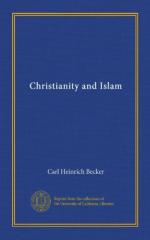With this hostility to marriage are probably connected the regulations concerning the covering of the body: in the ancient church only the face, the hands and the feet were to be exposed to view, the object being to prevent the suggestion of sinful thoughts: it is also likely that objections to the ancient habit of leaving the body uncovered found expression in this ordinance. Similar objections may be found in Muhammedan tradition; we may regard these as further developments of commands given in the Qoran, but it is also likely that Muhammed’s apocryphal statements upon the point were dictated by Christian religious theory. They often appear in connection with warnings against frequenting the public baths, which fact is strong evidence of their Christian origin. “A bad house is the bath: much turmoil is therein and men show their nakedness.” “Fear that house that is called the bathhouse and if any enter therein, let him veil himself.” “He who believes in God and the last Judgment, let him enter the bath only in bathing dress.” “Nakedness is forbidden to us.” There is a story of the prophet, to the effect that he was at work unclothed when a voice from heaven ordered him to cover his nakedness!
* * * * *
We thus see, that an astonishing similarity is apparent in the treatment even of questions where divergency is fundamental. Divergency, it is true, existed, but pales before the general affinity of the two theories of life. Our judgment upon Christian medievalism in this respect can be applied directly and literally to Muhammedanism. Either religion regards man as no more than a sojourner in this world. It is not worth while to arrange for a permanent habitation, and luxurious living is but pride. Hence the simplicity of private dwellings in mediaeval times both in the East and West. Architectural expense is confined




